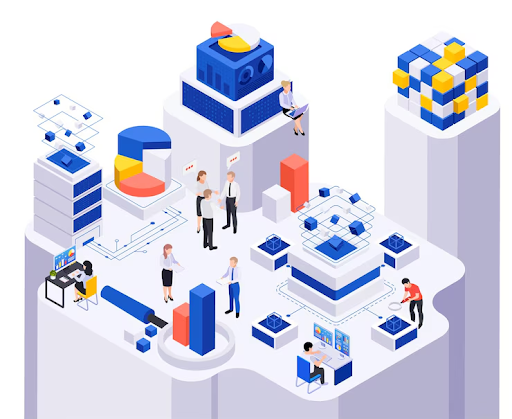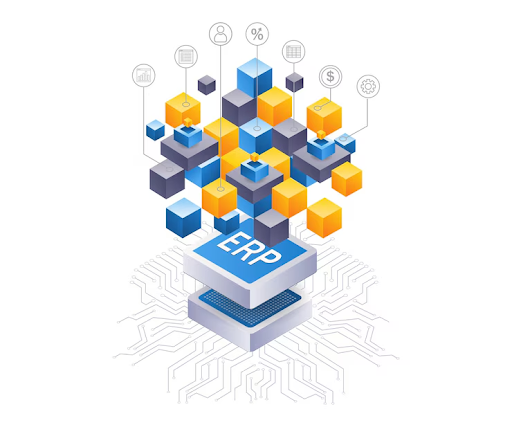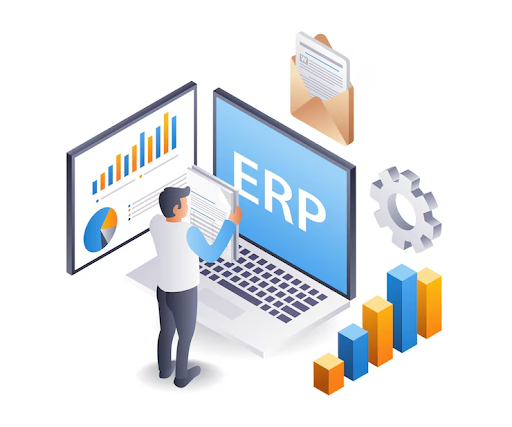In today's dynamic business landscape, seamless interdepartmental coordination is not merely an aspiration but a critical determinant of success. However, many organizations continue to grapple with the challenges arising from siloed departmental operations, characterized by a lack of effective communication and information sharing. The consequences include duplicated efforts, increased errors, ill-informed decision-making, and ultimately, an adverse impact on profitability. This is where Enterprise Resource Planning (ERP) systems emerge as a comprehensive solution, acting as a robust "bridge" that synchronizes all activities and data across departments, ushering in a new era of efficiency and internal cohesion.
This article will delve into the essential role of ERP in establishing this synchronization, clarifying how the system functions and the tangible benefits it delivers to businesses.
1. Challenges arising from departmental silos
When departments within an organization operate in isolation, lacking coordination and information sharing, numerous difficulties arise, negatively impacting overall operational efficiency. Key challenges include:
Reduced efficiency and productivity:
- Duplication of Effort: Departments may unknowingly undertake similar tasks, leading to wasted time and resources.
- Errors and Rework: A lack of synchronized information can cause departments to make decisions or execute tasks based on incomplete or outdated data, resulting in errors and the need for repeated work.
- Process Bottlenecks: Interdepartmental workflows are disrupted due to insufficient coordination and the untimely transfer of information, causing delays in task completion and hindering the ability to meet customer demands.
Ineffective information management:
- Data Silos: Each department stores information separately, making it challenging to aggregate, analyze, and gain a holistic view of the business situation.
- Data Inconsistency: Customer, product, and financial data, among others, can vary across departments, making it difficult to generate accurate and reliable reports.
- Difficult Information Access: Employees in one department may encounter difficulties or be denied access to necessary information from other departments to perform their duties effectively.
Suboptimal decision-making:
- Lack of Holistic Perspective: Decisions made by one department may not consider their impact on others, leading to localized and non-optimal choices for the overall business.
- Conflicts and Friction: A lack of understanding and coordination between departments can lead to conflicts regarding objectives, priorities, and work execution methods.
- Slow Response to Change: Due to limited communication and flexible coordination, the organization struggles to react swiftly to market shifts or evolving customer requirements.
Poor customer experience:
- Inconsistent Information: Customers may receive conflicting information from different company departments (e.g., sales and support), causing confusion and eroding trust.
- Slow Response Times: When departments do not coordinate effectively, the resolution of customer issues or requests can be prolonged.
- Lack of Personalization: The absence of a comprehensive view of customer interaction history and needs hinders the organization's ability to provide personalized service and build lasting relationships.
Negative corporate culture:
- Weakened Team Spirit: Departmental silos can foster a "my department's concern only" mentality, undermining collaboration and the organization's shared goals.
- Poor Communication: Limited interdepartmental communication and information sharing lead to misunderstandings and a lack of mutual trust among employees.
- Blame Culture and Unclear Accountability: When issues arise, departments may engage in blame-shifting rather than collaboratively seeking solutions.
2. ERP: Bridging departments – how the system operates

In traditional business environments, departments often function as "information silos" – each unit utilizes its own software, maintains separate data, and relies on constant inter-departmental report exchanges for task coordination. This can readily lead to errors, delays, and a lack of comprehensive oversight. Enterprise Resource Planning (ERP) systems emerge as a crucial bridge, integrating all departments onto a unified platform.
Centralized data – always consistent and in real-time
ERP stores all operational data across the enterprise within a single system. When one department inputs data (for example, a sales order from the sales department), the entire system automatically updates for relevant departments such as warehouse, accounting, production, and logistics. There's no need for inter-departmental emails or file attachments as in the past.
Automated and tightly linked workflow rocesses
The steps within work processes – from sales and procurement to production, accounting, and customer relationship management – are pre-configured within the ERP system. Consequently, when an action occurs in one department, related actions in other departments are automatically triggered.
Illustrative Examples:
- Sales representative creates a sales order ⟹ ERP checks inventory levels ⟹ If sufficient stock is available: automatically notifies the warehouse for order fulfillment ⟹ Simultaneously generates an invoice and updates revenue in accounting.
- If stock is insufficient ⟹ The system triggers the procurement or production process ⟹ Automatically sends a request to the purchasing or production department.
Department-specific interfaces, shared data foundation
ERP provides tailored work interfaces for each department (sales, accounting, warehouse, HR, etc.), yet all operate on a common data source. This ensures everyone "speaks the same data language," minimizing errors arising from inconsistent information.
Consolidated reporting, supporting executive decision-making
Leveraging aggregated data from multiple departments, leadership can access multi-dimensional analytical reports covering revenue, sales performance, inventory levels, costs, and profitability. This facilitates informed and timely strategic decision-making.
3. The specific role of ERP in inter-departmental synchronization

Enterprise Resource Planning (ERP) plays a pivotal role in synchronizing inter-departmental operations within an organization by providing a unified platform for data and business processes. The specific roles of ERP in achieving this include:
Establishing a "Single Source of Truth":
- Centralized Database: ERP consolidates data from all departments (finance, accounting, sales, marketing, manufacturing, HR, inventory management, etc.) into a central database. This eliminates disparate data silos where information is fragmented and inconsistent across departments.
- Data Consistency and Accuracy: When all departments operate on the same dataset, information becomes more consistent and accurate, minimizing errors arising from duplicate data entry or unsynchronized information.
- Facilitated Information Access and Sharing: Authorized departments can access and share real-time information, enabling a clearer understanding of other departments' activities and fostering informed, collaborative decision-making.
Automating and standardizing business processes:
- Integrated Workflows: ERP establishes interconnected workflows that bridge processes across departments. For instance, when the sales department creates an order, this information automatically flows to the warehouse for inventory checks, to accounting for invoicing and payment tracking, and potentially to manufacturing if additional production is required.
- Process Standardization: ERP facilitates the standardization of business processes across the entire enterprise, ensuring that all departments adhere to consistent rules and procedures. This enhances efficiency, reduces errors, and simplifies control.
- Task Automation: ERP automates numerous repetitive tasks involving multiple departments, freeing up employees to focus on more strategic initiatives.
Enhancing communication and collaboration:
- Real-time Information Visibility: Departments can monitor real-time activities and statuses relevant to their work in other departments. For example, the sales department can track the production status of customer orders, and the warehouse can view upcoming delivery schedules.
- Cross-departmental Reporting and Analytics: ERP enables the creation of comprehensive reports that integrate data from multiple departments, providing a holistic view of performance and inter-departmental issues.
- Integrated Collaboration Tools: Some ERP systems incorporate communication and collaboration tools (e.g., notification systems, document sharing), making it easier for employees across departments to communicate and coordinate their work.
Supporting more effective decision-making:
- Holistic Business Overview: With integrated data and multi-dimensional reporting, managers gain a comprehensive understanding of the entire organization's operations, extending beyond the confines of their own department.
- Data-Driven Decisions: Decisions are based on accurate, real-time information shared across departments, ensuring alignment and effectiveness.
- Improved Forecasting and Planning: Historical and current data from all departments enables the organization to more accurately forecast demand, plan production, procurement, and other activities.
4. Benefits of ERP implementation for internal synchronization

Enhanced information flow:
- Centralized Data Repository: ERP establishes a unified database where information from all departments is centrally stored and managed. This eliminates information silos, ensuring data consistency and facilitating easy access for relevant departments.
- Real-time Information Sharing: Departments can monitor and update information in real time, enabling them to understand the operational status of other units and coordinate more effectively.
- Reduced Errors: With synchronized and consistent data, errors arising from duplicate data entry or mismatched information across departments are significantly minimized.
Optimized workflow:
- Interdepartmental Process Automation: ERP automates the transfer of tasks between departments, streamlining workflows and accelerating processes.
- Standardized Processes: The system helps standardize business processes across the entire organization, ensuring all departments adhere to a unified approach, reducing redundancy and waste.
- Efficient Monitoring and Management: ERP provides tools to track task progress and departmental performance, enabling managers to easily identify bottlenecks and implement improvement measures.
Strengthened coordination and collaboration:
- Improved Communication: With readily available and real-time shared information, departments can communicate and collaborate more effectively on tasks.
- Enhanced Team Cohesion: As departments gain a clearer understanding of each other's roles and contributions to the company's overall objectives, team spirit and cooperation are strengthened.
- Faster Issue Resolution: The ability to share information and coordinate between departments enables the organization to resolve emerging issues more quickly and efficiently.
Support for accurate decision-making:
- Holistic View: ERP provides a comprehensive overview of the entire organization's operations, empowering managers to make strategic decisions based on accurate and complete data.
- Multi-dimensional Reporting and Analysis: The system allows for the creation of integrated reports, combining data from multiple departments, facilitating effective performance analysis and identification of improvement opportunities.
- Improved Forecasting and Planning: Based on synchronized historical and current data, the organization can more accurately forecast demand and develop more precise business plans.
Increased efficiency and cost reduction:
- Enhanced Productivity: Eliminating redundant tasks, automating manual processes, and optimizing workflows enable employees to work more efficiently.
- Reduced Operating Costs: More effective inventory management, optimized procurement and production processes, and the minimization of errors and waste contribute to significant operational cost savings for the organization.
5. Which businesses should implement ERP to synchronize departments?
Here are indicators suggesting a business needs ERP for departmental synchronization:
- Fragmented and inconsistent information: Customer data, product information, financial records, etc., are scattered across multiple locations, hindering aggregation and analysis.
- Manual and non-automated workflows: Departments perform numerous repetitive tasks, leading to wasted time and potential errors.
- Ineffective communication and coordination: Departments operate in silos with limited information exchange and collaboration.
- Difficulty in decision-making: Lack of real-time information and an overall view of the entire business operations.
- Challenges in growth and scaling: The current management system no longer accommodates the increasing complexity of the business.
- Desire to enhance efficiency and reduce costs: Recognition of wasted time and resources due to a lack of synchronization.
- Requirements for complex reporting and analysis: Need for comprehensive, multi-dimensional reports to evaluate operational performance.
- Aspiration to improve customer experience: Awareness of delays and a lack of professionalism in service due to poor inter-departmental coordination.
Specific types of businesses that should particularly consider ERP implementation:
- Small and Medium-sized Enterprises (SMEs) and Large Enterprises: With complex operations, numerous departments, and substantial data volumes, ERP facilitates efficient management and synchronization of all activities.
- Businesses operating in industries with complex processes: Manufacturing, construction, retail, distribution, logistics, etc., are sectors where synchronization between departments (e.g., sales, warehouse, production, accounting) is critical for survival.
- Businesses with multiple branches or business locations: ERP enables centralized management and information synchronization across different locations.
- Businesses with complex supply chains: ERP helps effectively manage the entire process from suppliers, manufacturing, warehousing, and logistics to customers.
- Businesses undergoing rapid growth: ERP provides a solid foundation to manage expansion and maintain operational efficiency.
6. Conclusion
In conclusion, Enterprise Resource Planning (ERP) systems play an indispensable role in fostering synergy across departments within a modern enterprise. From establishing a unified data platform and automating interdepartmental processes to enhancing communication and supporting real-time, data-driven decision-making, ERP has proven its ability to break down traditional silos, creating a seamlessly coordinated and efficient working environment.
The adoption of ERP is not merely a technological solution but a strategic imperative, enabling businesses to optimize resources, enhance productivity, improve customer experience, and build a robust foundation for sustainable growth. In an increasingly competitive landscape, the internal synchronization facilitated by ERP represents an invaluable competitive advantage, empowering organizations to excel and achieve significant success. Contact us today for a consultation and receive complimentary resources on the latest technology trends.